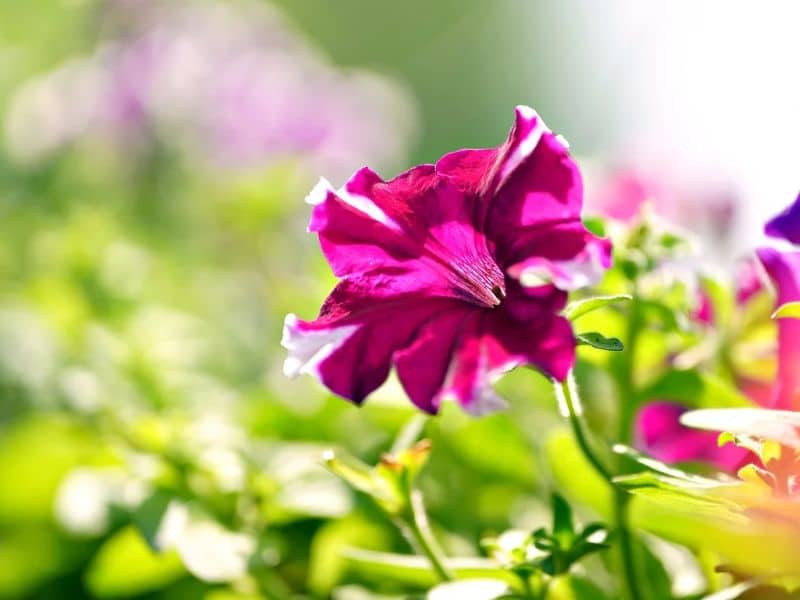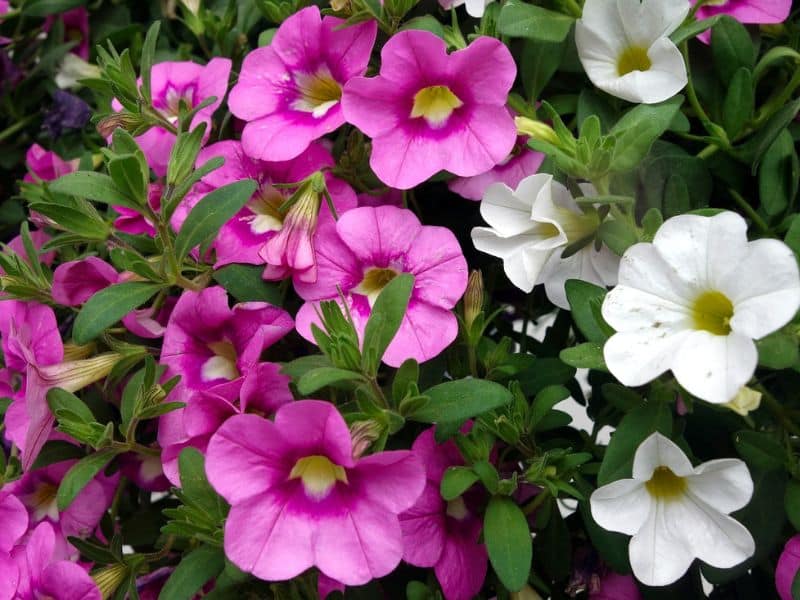Are your vibrant petunias losing their charm due to yellowing leaves? You’re not alone.
Yellowing leaves, a common issue among petunia enthusiasts, can steal the show from your garden’s star performers. But don’t despair – understanding the root cause is the first step towards restoring your petunias’ health.
In this article, we’ll delve into the reasons behind this phenomenon and offer practical solutions. Armed with this knowledge, you’ll be well on your way to revive your petunias’ lush green foliage and keep them blooming beautifully all season long. So, let’s unlock the secrets to maintaining the perfect petunias.
Understanding Why Petunia Leaves Turn Yellow
Petunias, known for their vibrant colors and lush foliage, may well lose this appeal as their leaves turn yellow. Let’s delve into why this may well occur and learn some actionable solutions to revive their beauty.
Common Causes of Yellowing Leaves
Yellowing petunia leaves denote a message of distress from the plant. Various culprits instigate this transformation, offering clues to underlying issues. Here are a few prevalent causes:
- Watering Problems: Excessively watering petunias places roots under stress, which manifests as yellow leaves. Conversely, prolonged dry periods infuse the same stress, leading to similar results.
- Nutrient Deficiency: Petunias necessitate specific nutrients, such as iron or nitrogen. A lack thereof results in the leaves changing color.
- Pest Infestation: Pests, such as aphids, gnaw on leaves, causing a yellow discoloration.
By identifying these issues early, you can take steps towards reclaiming your petunias’ lush green glory.
The Role of Environmental Factors
The environment plays a pivotal role in the health of your petunias. Factors such as light, temperature, and soil pH all contribute to the color and vibrancy of petunia leaves. Let’s examine each more closely:
- Light: Petunias thrive under full sun but prolonged exposure to intense sunlight may cause leaf scorch, turning them yellow.
- Temperature: Petunias prefer mild climates. An abrupt cold snap or heatwave can stress the plant, causing yellowing leaves.
- Soil pH: Petunias need slightly acidic to neutral soil. A pH imbalance can lead to nutrient deficiencies and thus yellow leaves.
Resolving these environmental issues may well springboard your petunias back to their optimal health. It’s about understanding the message your petunias are trying to convey and responding accordingly. Your garden’s beauty depends on it.
Diagnosing the Problem

Identifying why your petunia leaves are turning yellow can be challenge. But, once you know what specific issues to look out for, diagnosis becomes a simpler task. Below we’ll take a detailed look at some common culprits.
Nutrient Deficiencies
Nutrient deficits can cause petunia leaves to yellow. These include nitrogen, iron, and magnesium deficiencies. Do your plants have stunted growth, along with yellowing leaves? Nitrogen deficiency could be at play. If the yellowing is more pervasive towards the leaf tips and edges, it echoes a possible iron deficiency.
Conversely, an older petunia showcasing yellowing areas between its leaf veins may well signify a magnesium deficiency. Each of these deficiencies can be addressed by fortifying your soil with the proper nutrients, while ensuring you avoid over-fertilization, as it can damage your plants further.
Watering Issues
Incorrect watering practices, either overwatering or underwatering, lead the list of reasons for yellowing petunia leaves. Overwatered petunias develop yellow, wilted leaves as their roots drown and start to rot.
Underwatered ones exhibit brittle, yellow leaves due to dehydration. Equilibrium is key here. Establish a regular watering schedule, and vary it depending upon the season and weather changes.
Diseases and Pests
Fungal diseases, like root rot or powdery mildew, can turn your petunia leaves from green to yellow, while pest infestations, such as aphids or whiteflies, cause similar damage.
Spot foliar diseases by the presence of white powdery substance on the leaves, while sickly yellow leaves combined with blackened roots signal root rot. Inspect the undersides of your leaves frequently for pests. Diligent management of these threats protects your petunia’s health and maintains their vibrant green leaves.
Preventive Measures for Healthy Petunias
Maintaining the health of your petunias ties down to a handful of critical practices – starting from the right soil mix to appropriate watering techniques. In this section, we’ll delve into these key aspects and demystify their importance in preventing the yellowing of petunia leaves.
Proper Soil and Fertilization
Good soil forms the foundation for healthy petunias. Opt for well-draining soil, enabling roots to receive adequate oxygen, a crucial requirement for vibrant, green leaves.
Apart from that, you’ll need to provide your petunias with balanced fertilizer, one high in iron and magnesium specifically. By doing so, your plants receive all essential elements narrowing the chances of nutrient deficiency, consequently averting yellow leaves.
Consider incorporating compost into your soil annually, reaffirming a high-nutrient environment ideal for your petunias. It’s also beneficial to test your soil’s pH every few years. Petunias thrive in a slightly acidic to neutral pH range (6.0 – 7.0). If your soil drifts away from this range, you can add lime or sulfur to adjust it.
Adequate Watering Techniques
When it comes to watering, remember, less is more. Overwatering tends to drown the roots, restricting oxygen absorption and triggering leaf yellowing. A watering schedule based on the plant’s specific needs and environmental conditions proves efficient.
Consistency forms the key to optimal watering. Petunias prefer infrequent, but deep watering which helps in developing robust root systems. This method also minimizes the risk of water-borne diseases that surface from waterlogged soil. To judge your plant’s watering needs, stick a finger into the soil. If it feels dry about an inch down, it’s time to water.
On hot summer days, early morning watering proved beneficial. It allows enough time for the water to seep deep into the soil before the scorching afternoon sun induces evaporation. In the end, remember your petunias are unique, understanding their individual needs and tailoring your care around it, aids in preventing yellow leaves and fostering healthy petunias.
Solutions for Yellowing Petunia Leaves

In light of the previous discussion on yellowing petunia leaves, here are some practical solutions you can implement.
Treating Nutrient Deficiencies
Ready to combat nutrient deficits that turn green petunia leaves yellow? Begin by testing the soil’s pH level. Aim for a slightly acidic reading of 6.0 to 6.5 for optimal petunia growth.
If the ground is too alkaline—say, a pH level above 7.0—you can add sulfur to decrease it. Conversely, incorporate limestone if soil is on the acidic side, hovering below 6.0.
Next, apply a balanced fertilizer regularly. A 20-20-20 mix, infused with iron and magnesium, rectifies common nutrient deficiencies. Embed the fertilizer into the top layers of soil. Water immediately. Do this at least once a month during the blooming season.
Adjusting Watering Habits
Irrigation habits play an integral role in petunia health. Watch for over-watering indicators – wilting plants, and yellowing leaves. If your petunias exhibit this, tune down watering frequency.
Let’s practice a ‘soak and dry’ method instead. Thoroughly drench the soil then wait until it’s barely moist before the next watering session. This process encourages deep root growth and improves drought resistance.
If possible, water your petunias early in the morning. This technique decreases water evaporation, holds soil moisture, and reduces the risk of leaf-burning in hotter months.
Handling Pests and Diseases
Petunias, sadly, can be a magnet for pests and diseases. Aphids, whiteflies, slugs, and botrytis blight are potential threats. Protect your petunias through regular inspection and early intervention. In the case of insects, try introducing natural predators like ladybugs, or set bait for slugs.
Botrytis blight, a common fungal disease, can be controlled by removing infected plants and debris to prevent spore spread.
Utilizing these strategies can assist in reverting your yellowing petunia leaves to their healthy green state. Apply these changes, monitor patiently, and let your petunias thrive.
Reviving Your Petunias
Petunias, once distressed, can regain their vitality if given appropriate care. Here are vital recommendations for reviving your yellowing petunias.
Pruning and Maintenance Tips
Proper maintenance of petunias starts with pruning, a process that boosts new growth. Start by removing yellow, dried, or infected parts, ensuring you avoid harming the healthy leaves or stems.
Secondly, consistent cleaning of your plants plays a crucial role in keeping pests and diseases at bay. Clean the surrounding area of fallen leaves and other debris which often harbor insects and fungus.
Lastly, incorporate a balanced fertilizing routine for your petunias. It’s not just about applying fertilizers; it’s also about timing. Fertilize during the growing season but reduce frequency during the dormant phase.
When to Seek Professional Advice
Despite your best efforts, if the condition of your petunias fails to improve or continues to deteriorate, it’s high time you sought professional help. For example, if the leaves keep yellowing despite regular water, sunlight, and nutrient supply, an expert can help identify any underlying issues.
Experienced horticulturists or plant pathologists are equipped to detect hidden problems such as root rot or soil-borne illnesses that can adversely impact your petunias. They can provide an accurate diagnosis and effective treatment plan.
So, never hesitate to reach out to professionals; their expertise can be the difference between the survival and demise of your petunias.
FAQs
Why are my petunia leaves turning yellow?
Yellowing leaves in petunias may be due to issues like watering problems, nutrient deficiencies, and pests. Environmental factors can also have a significant impact on the leaf color of your petunias.
What are the common causes of yellow leaves in petunias?
Common causes of yellowing petunia leaves include over or under-watering, insufficient nutrients, pests, or disease. Changes in environmental conditions, like inconsistent light or temperature, can also affect the color and health of your leaves.
What are some solutions to prevent yellowing of petunia leaves?
To prevent yellowing of petunia leaves, you can adjust soil pH, use balanced fertilizers, and improve your watering habits. Regular pruning, maintaining cleanliness in the growing area, and appropriate fertilizing can also greatly help.
When should I seek professional help for my petunias?
If you’ve tried adjusting your care practices but your petunias still have yellow leaves or show signs of distress, it may be time to seek professional help. Experts can accurately diagnose and treat hidden problems like root rot or soil-borne diseases.
See more: Leaves Turning Yellow During Flowering: Causes and Prevention Techniques







